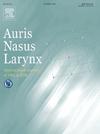Relationship between timing of tympanostomy tube insertion and mastoid air cell development in children with otitis media
IF 1.5
4区 医学
Q2 OTORHINOLARYNGOLOGY
引用次数: 0
Abstract
Objective
: This study aimed to evaluate the effect of age at tympanostomy tube insertion on mastoid air cell development, focusing on whether insertion before 3 years of age is associated with more favorable pneumatization.
Methods
: We retrospectively analyzed 39 children (71 ears) who developed tympanic membrane perforation following tube insertion (tube group), including cases primarily associated with recurrent acute otitis media (rAOM) and otitis media with effusion (OME). The control group consisted of 41 children (41 ears) with congenital cholesteatoma, using their contralateral normal ears as controls. Mastoid air cell area was measured on axial temporal bone CT using two standard slices. Linear mixed-effects models were applied to assess associations with age, sex, laterality, and tube insertion age (<3 vs. ≥3 years). Age-specific comparisons between the tube and control groups were also performed.
Results
: The control group included 112 CT images, and the tube group included 71 images (46 with OME, 25 with rAOM). The average mastoid air cell area was 437.7 ± 181.6 mm² in the control group and 263.8 ± 139.6 mm² in the tube group. In controls, mastoid air cell area increased significantly with age (p < 0.001), while sex and laterality were not significant predictors. In the rAOM subgroup, children who underwent tube insertion before age 3 had mastoid air cell areas most similar to those of controls (e.g., age 1: p = 0.284), whereas insertion at ≥3 years was associated with significantly smaller areas across all groups (p < 0.001). No consistent age-related recovery was observed after age 3.
Conclusion
: Tympanostomy tube insertion before 3 years of age, especially in patients with rAOM, is associated with mastoid air cell development closer to that of healthy controls. Early intervention may play a key role in preserving mastoid pneumatization and preventing chronic middle ear sequelae.
中耳炎患儿中耳炎鼓室插管时机与乳突空气细胞发育的关系
目的:本研究旨在评估年龄对乳突空气细胞发育的影响,重点关注3岁前插入鼓膜造瘘管是否与更有利的充气有关。方法:回顾性分析39例(71耳)置管后出现鼓膜穿孔的患儿(管组),包括复发性急性中耳炎(rAOM)和中耳炎伴渗出性中耳炎(OME)。对照组41例先天性胆脂瘤患儿(41耳),对侧正常耳为对照。在轴向颞骨CT上采用两张标准切片测量乳突空气细胞面积。线性混合效应模型用于评估与年龄、性别、侧位和插管年龄(3岁vs.≥3岁)的关系。还进行了管组和对照组之间的年龄特异性比较。结果:对照组112张CT图像,管组71张(OME 46张,rAOM 25张)。对照组乳突空气细胞平均面积为437.7±181.6 mm²,管组乳突空气细胞平均面积为263.8±139.6 mm²。在对照组中,乳突空气细胞面积随着年龄的增长而显著增加(p < 0.001),而性别和侧卧不是显著的预测因素。在rAOM亚组中,在3岁前插入导管的儿童乳突空气细胞面积与对照组最相似(例如,1岁:p = 0.284),而在所有组中,≥3岁插入导管的儿童乳突空气细胞面积均显著减小(p < 0.001)。3岁后未观察到与年龄相关的持续恢复。结论:3岁前插入鼓膜造瘘管,尤其是rAOM患者,与乳突空气细胞发育更接近健康对照组有关。早期干预可能对保留乳突气化和预防慢性中耳后遗症起关键作用。
本文章由计算机程序翻译,如有差异,请以英文原文为准。
求助全文
约1分钟内获得全文
求助全文
来源期刊

Auris Nasus Larynx
医学-耳鼻喉科学
CiteScore
3.40
自引率
5.90%
发文量
169
审稿时长
30 days
期刊介绍:
The international journal Auris Nasus Larynx provides the opportunity for rapid, carefully reviewed publications concerning the fundamental and clinical aspects of otorhinolaryngology and related fields. This includes otology, neurotology, bronchoesophagology, laryngology, rhinology, allergology, head and neck medicine and oncologic surgery, maxillofacial and plastic surgery, audiology, speech science.
Original papers, short communications and original case reports can be submitted. Reviews on recent developments are invited regularly and Letters to the Editor commenting on papers or any aspect of Auris Nasus Larynx are welcomed.
Founded in 1973 and previously published by the Society for Promotion of International Otorhinolaryngology, the journal is now the official English-language journal of the Oto-Rhino-Laryngological Society of Japan, Inc. The aim of its new international Editorial Board is to make Auris Nasus Larynx an international forum for high quality research and clinical sciences.
 求助内容:
求助内容: 应助结果提醒方式:
应助结果提醒方式:


